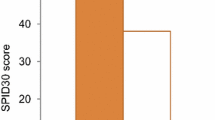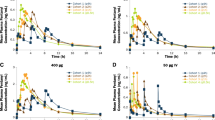Abstract
Background and Objectives: Fentanyl buccal soluble film (FBSF) is a small, bilayered, water-soluble polymer film (BioErodible MucoAdhesive; BEMA™) that adheres to the buccal mucosa and rapidly delivers fentanyl into the systemic circulation. It is approved for the treatment of cancer breakthrough pain in adult opioid-tolerant patients. The objective of this study was to evaluate the dose proportionality of the pharmacokinetics of FBSF in healthy subjects across a range of doses.
Methods: This was a phase I, open-label, single-dose, three-period, Latin-square crossover study in which 12 healthy subjects received single FBSF doses of 200, 600 and 1200 μg with 72 hours between doses. Oral naltrexone was administered to each subject prior to and after each study dose. Serial venous blood samples were collected for 48 hours after study drug administration. Adverse events were recorded throughout the study. Dose linearity was examined using a power model (P=a×Doseb), where P represents the dependent variable (maximum plasma drug concentration [Cmax], area under the plasma concentration-time curve [AUC] from time zero to time of the last measurable concentration [AUClast], or AUC from time zero to infinity [AUC∞]), and a and b are constants. A value of b ≈ 1 indicated linearity.
Results: Following administration of FBSF doses of 200–1200 μg, mean Cmax values increased in a linear manner with values ranging from 0.383 ng/mL to 2.19ng/mL, respectively. Mean AUClast values increased from 3.001 ng ·/mL to 19.17 ng·h/mL and mean AUC∞ increased in a linear manner from 3.456 ng·h/mL to 20.43 ng ·h/mL. All reported adverse events were considered to be mild to moderate in severity.
Conclusions: This study demonstrates that peak fentanyl plasma concentrations and overall exposure increase in a dose-proportional manner following administration of FBSF.






Similar content being viewed by others
References
Gutstein H, Akil H. Opioid analgesics. In: Hardman J, Limbird L, editors. Goodman and Gilman's the pharmacological basis of therapeutics. 10th ed. Maidenhead: McGraw-Hill: 2001: 569–619
Hanks GW, Nugent M, Higgs CM, et al. Oral transmucosal fentanyl citrate in the management of breakthrough pain in cancer: an open, multicentre, dose-titration and long-term use study. Palliat Med 2004 Dec; 18(8): 698–704
Feierman DE, Lasker JM. Metabolism of fentanyl, a synthetic opioid analgesic, by human liver microsomes: role of CYP3A4. Drug Metab Dispos 1996 Sep; 24(9): 932–9
Portenoy RK, Hagen NA. Breakthrough pain: definition, prevalence and characteristics. Pain 1990 Jun; 41(3): 273–81
Inturrisi CE. Clinical pharmacology of opioids for pain. Clin J Pain 2002 Jul–Aug; 18(4 Suppl.): S3–13
Coluzzi PH, Schwartzberg L, Conroy JD, et al. Breakthrough cancer pain: a randomized trial comparing oral transmucosal fentanyl citrate (OTFC) and morphine sulfate immediate release (MSIR). Pain 2001 Mar; 91(1-2): 123–30
Portenoy RK, Payne R, Coluzzi P, et al. Oral transmucosal fentanyl citrate (OTFC) for the treatment of breakthrough pain in cancer patients: a controlled dose titration study. Pain 1999 Feb; 79(2-3): 303–12
Farrar JT, Cleary J, Rauck R, et al. Oral transmucosal fentanyl citrate: randomized, double-blinded, placebo-controlled trial for treatment of breakthrough pain in cancer patients. J Natl Cancer Inst 1998 Apr 15; 90(8): 611–6
Slatkin NE, Xie F, Messina J, et al. Fentanyl buccal tablet for relief of breakthrough pain in opioid-tolerant patients with cancer-related chronic pain. J Support Oncol 2007 Jul–Aug; 5(7): 327–34
Portenoy RK, Taylor D, Messina J, et al. A randomized, placebo-controlled study of fentanyl buccal tablet for breakthrough pain in opioid-treated patients with cancer. Clin J Pain 2006 Nov–Dec; 22(9): 805–11
Rauck R, North J, Gever LN, et al. Fentanyl buccal soluble film (FBSF) for breakthrough pain in patients with cancer: a randomized, double-blind, placebo-controlled study. Ann Oncol 2010 Jun; 21(6): 1308–14
Streisand JB, Varvel JR, Stanski DR, et al. Absorption and bioavailability of oral transmucosal fentanyl citrate. Anesthesiology 1991 Aug; 75(2): 223–9
Vasisht N, Gever LN, Tagarro I, et al. Evaluation of the single- and multiple-dose pharmacokinetics of fentanyl buccal soluble film in normal healthy volunteers. J Clin Pharmacol 2010 Jul; 50(7): 785–91
Onsolis (fentanyl buccal soluble film). Prescribing information. Meda Inc. 2009
Vasisht N, Gever LN, Tagarro I, et al. Formulation selection and pharmacokinetic comparison of fentanyl buccal soluble film with oral transmucosal fentanyl citrate: a randomized, open-label, single-dose, crossover study. Clin Drug Investig 2009; 29(10): 647–54
Gordon D, Schroeder M. Oral transmucosal fentanyl citrate: OTFC (ACTIQ) #103. J Palliat Med 2008 May; 11(4): 633–4
Gever L, Wheeler W, Hill W. Fentanyl absorption from fentanyl buccal soluble film (FBSF) in the presence of mucositis. Poster session presented at: PAINWeek — The National Conference on Pain for Frontline Practitioners; 2010 Sep 8-11; Las Vegas (NV)
Slatkin N, Hill W, Finn A. The safety of fentanyl buccal soluble film (FBSF) use for breakthrough (BTP) pain in cancer patients. Poster session presented at: 26th Annual Meeting of the American Academy of Pain Medicine (AAPM); 2010 Feb 3–6; San Antonio (TX)
Acknowledgements
The authors thank MK Grandison, PhD, Nila Bhana, MSc, and Alan J. Klopp, PhD, of inScience Communications, a Wolters Kluwer business, for providing medical writing support funded by Meda Pharmaceuticals, Inc.
Andrew L. Finn, PharmD, and Niraj Vasisht, PhD, are employees and shareholders of BioDelivery Sciences International, Inc., the developer of FBSF. Drs Finn and Vasisht are also cited as inventors on the FBSF patent applications. Jeffrey G. Stark, PhD, is an employee of Worldwide Clinical Trials Drug Development Solutions (formerly CEDRA Corporation), the research facility that conducted the study. Larry N. Gever, PharmD, is the Director of Medical Affairs at Meda Pharmaceuticals, Inc., the company that is marketing FBSF. Ignacio Tagarro, PhD, is an employee of Meda Pharmaceuticals, Inc.
Author information
Authors and Affiliations
Corresponding author
Rights and permissions
About this article
Cite this article
Finn, A.L., Vasisht, N., Stark, J.G. et al. Dose Proportionality and Pharmacokinetics of Fentanyl Buccal Soluble Film in Healthy Subjects. Clin Drug Investig 32, 63–71 (2012). https://doi.org/10.2165/11594670-000000000-00000
Published:
Issue Date:
DOI: https://doi.org/10.2165/11594670-000000000-00000




